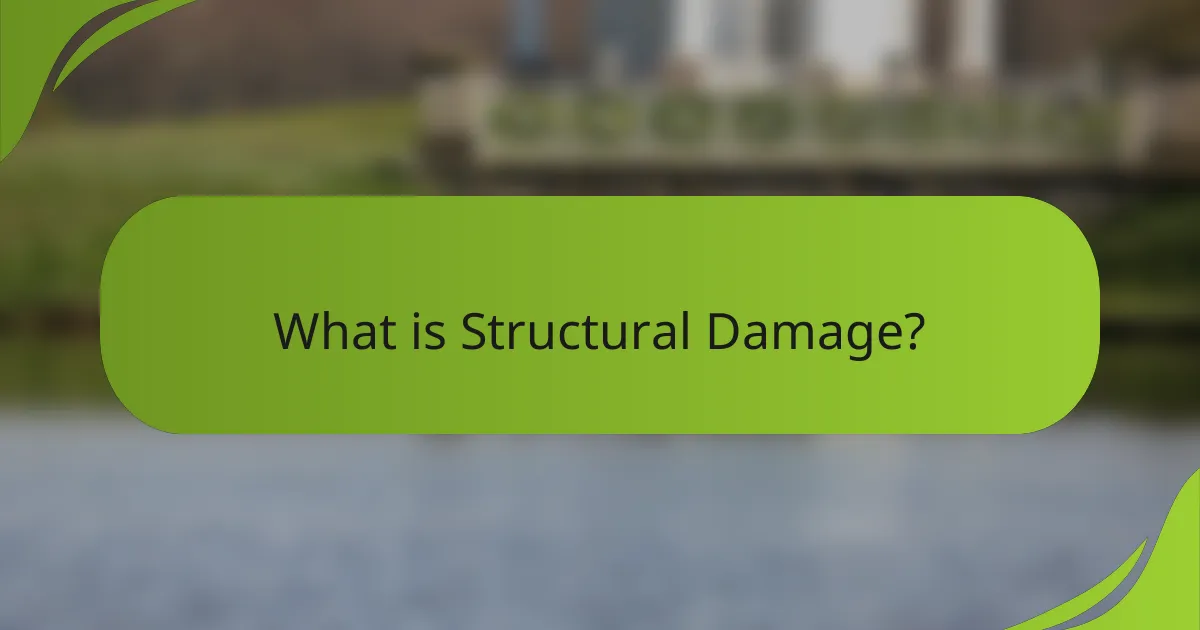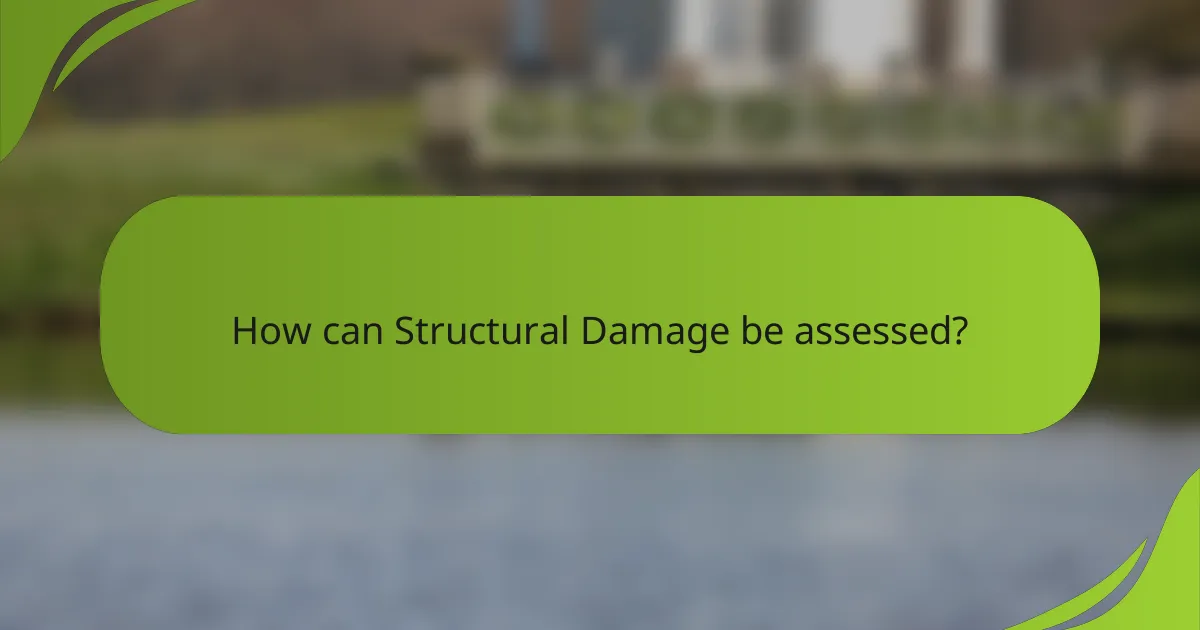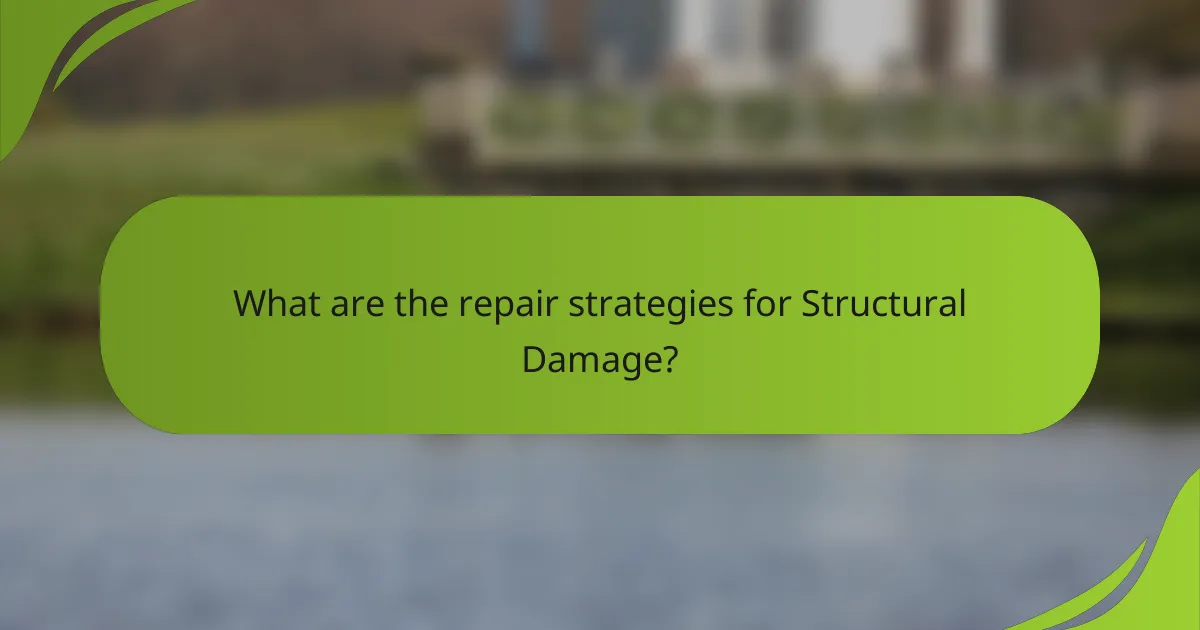Structural damage is defined as harm that compromises the integrity, safety, and functionality of buildings or structures. Common causes include natural disasters, poor construction practices, and deterioration over time, with visible signs such as cracks, sagging roofs, and uneven floors. Assessing structural damage involves visual inspections, non-destructive testing methods, and structural analysis to determine the extent of damage and necessary repairs. Repair strategies encompass assessment, reinforcement, and restoration techniques aimed at ensuring safety and prolonging the structure’s lifespan. Regular maintenance is essential in preventing future damage and minimizing repair costs.

What is Structural Damage?
Structural damage refers to harm that affects the integrity of a building or structure. This damage can compromise safety and functionality. Common causes include natural disasters, poor construction, and wear over time. Signs of structural damage may include cracks in walls, sagging roofs, and uneven floors. According to the American Society of Civil Engineers, structural damage can lead to significant repair costs and safety hazards. Addressing structural damage promptly is crucial to prevent further deterioration.
How is Structural Damage Defined?
Structural damage is defined as a physical impairment to a building’s integrity. This impairment can result from various factors such as natural disasters, wear and tear, or design flaws. Common signs include cracks in walls, sagging roofs, and uneven floors. The severity of structural damage can affect safety and functionality. Structural assessments often involve inspections and evaluations by qualified professionals. These assessments help determine the extent and necessary repairs for the damage. Accurate definitions and assessments are critical for maintaining building safety and compliance with regulations.
What are the key characteristics of Structural Damage?
Structural damage is characterized by visible cracks, distortion, and misalignment in a building’s framework. Cracks may appear in walls, foundations, and ceilings. Distortion can lead to uneven floors or doors that do not close properly. Misalignment often results in structural components that are no longer plumb or level. These signs indicate potential underlying issues, such as foundation settlement or material fatigue. The presence of water intrusion can exacerbate these conditions, leading to further deterioration. Regular inspection can help identify these characteristics early, allowing for timely repairs.
How does Structural Damage impact safety and functionality?
Structural damage significantly compromises safety and functionality. It can lead to structural failure, posing risks to occupants. For example, compromised beams may collapse under weight. Cracks in walls can indicate foundational issues. These problems can cause injuries or fatalities. Additionally, structural damage often results in costly repairs. It disrupts the intended use of a building. In commercial settings, this can lead to lost revenue. Overall, safety and functionality are severely impacted by structural damage.
What are the common causes of Structural Damage?
Common causes of structural damage include poor construction practices, natural disasters, and soil movement. Poor construction practices can lead to inadequate support and material failure. Natural disasters such as earthquakes, floods, and hurricanes exert significant forces on structures. Soil movement, including erosion and settling, can undermine foundations. Additionally, water intrusion can cause corrosion and weaken materials. Aging infrastructure also contributes to structural deterioration over time. Each of these factors can compromise the integrity of a building, leading to costly repairs and safety hazards.
How do environmental factors contribute to Structural Damage?
Environmental factors significantly contribute to structural damage by exerting stress on materials. Weather conditions, such as heavy rainfall, can lead to water infiltration. This infiltration promotes corrosion in metal structures and weakening of concrete. Temperature fluctuations cause expansion and contraction in building materials. Such movements can create cracks and structural weaknesses. Additionally, natural disasters like earthquakes and floods impose extreme forces on structures. These forces can exceed the design limits, resulting in failures. Soil erosion and shifting can destabilize foundations, leading to further damage. According to the Federal Emergency Management Agency, approximately 25% of homes in flood-prone areas are at risk of structural damage.
What role do construction defects play in Structural Damage?
Construction defects significantly contribute to structural damage. These defects can arise from poor workmanship, inadequate materials, or design flaws. They often lead to issues such as cracks, water intrusion, and compromised load-bearing capabilities. For instance, a study by the National Institute of Standards and Technology found that over 50% of building failures are linked to construction defects. Such failures can escalate repair costs and pose safety risks. Addressing these defects promptly is crucial for maintaining structural integrity.
What are the signs of Structural Damage?
Signs of structural damage include visible cracks in walls and foundations. Cracks may widen over time, indicating worsening conditions. Doors and windows may become misaligned or difficult to open. Uneven floors can signal underlying structural issues. Water stains or mold growth often suggest moisture problems affecting structural integrity. A sagging roof or ceiling may indicate support failure. These signs require immediate inspection by a qualified professional to assess the extent of damage. Timely intervention can prevent further deterioration and costly repairs.
What visual indicators should be monitored for Structural Damage?
Cracks in walls and ceilings are primary visual indicators of structural damage. They can vary in size and direction. Horizontal cracks often indicate serious issues. Vertical cracks may suggest minor settling. Bowing or bulging walls signal potential failure. Uneven floors can indicate shifting foundations. Doors and windows that stick may reflect misalignment. Water stains on ceilings or walls suggest leaks that can weaken structures. Regular inspection of these indicators is crucial for early detection.
How can changes in building performance signal Structural Damage?
Changes in building performance can signal structural damage through observable alterations in stability, safety, and functionality. For instance, cracks in walls or ceilings may indicate shifting foundations. Unusual settling or movement can lead to misalignment of doors and windows. Additionally, significant changes in energy efficiency may suggest insulation failure linked to structural issues. Structural integrity can also be compromised by moisture intrusion, leading to material degradation. These performance changes often precede more severe damage, making early detection crucial. Regular inspections can help identify these signs before they escalate into major problems.

How can Structural Damage be assessed?
Structural damage can be assessed through visual inspections, non-destructive testing, and structural analysis. Visual inspections involve examining visible signs such as cracks, deformations, and rust. Non-destructive testing methods include ultrasonic testing and radiography, which help detect internal flaws without damaging the structure. Structural analysis uses engineering principles to evaluate load capacities and material integrity. These assessment methods are crucial for ensuring safety and determining necessary repairs. Research shows that regular assessments can prevent further deterioration and costly repairs.
What methods are used to evaluate Structural Damage?
Visual inspection is a common method used to evaluate structural damage. It involves examining the structure for visible signs of distress, such as cracks, deformations, and discoloration. This method is often the first step in assessing structural integrity.
Non-destructive testing (NDT) techniques are also employed. These include ultrasonic testing, radiographic testing, and magnetic particle testing. NDT allows for the evaluation of internal flaws without causing damage to the structure.
Load testing is another method used to assess structural performance. It involves applying a known load to the structure and measuring its response. This helps determine if the structure can safely support intended loads.
Structural health monitoring systems can be installed for ongoing evaluation. These systems use sensors to continuously monitor parameters like strain, displacement, and vibrations.
Each of these methods provides valuable information about the condition of a structure. They help engineers make informed decisions about necessary repairs or reinforcements.
How do visual inspections help in assessing Structural Damage?
Visual inspections help in assessing structural damage by allowing experts to identify visible signs of deterioration. These inspections can reveal cracks, deformations, and rust that indicate underlying issues. Observing the condition of materials and connections provides insights into structural integrity. Visual assessments are often the first step in a comprehensive evaluation process. They are cost-effective and can be conducted quickly. According to the American Society of Civil Engineers, regular visual inspections are essential for maintenance and safety. This proactive approach helps prevent more severe damage and costly repairs.
What tools and technologies are available for assessing Structural Damage?
Tools and technologies for assessing structural damage include non-destructive testing (NDT) methods, structural health monitoring (SHM) systems, and advanced imaging techniques. NDT methods like ultrasonic testing and radiography detect internal flaws without harming the structure. SHM systems use sensors to monitor structural integrity in real-time, providing data on stress, strain, and vibrations. Advanced imaging techniques, such as infrared thermography and laser scanning, visualize surface conditions and identify hidden issues. These technologies enhance safety and maintenance by providing accurate assessments of structural conditions.
What steps are involved in a Structural Damage assessment?
The steps involved in a Structural Damage assessment include visual inspection, documentation, and analysis. First, a trained professional conducts a visual inspection of the structure. This inspection identifies visible signs of damage such as cracks, deformations, or water intrusion. Next, detailed documentation of the findings is created. This documentation includes photographs and notes on the extent and location of the damage. Following documentation, a thorough analysis is performed. This analysis assesses the severity and potential causes of the damage. Structural integrity tests may also be conducted to evaluate load-bearing capacity. Finally, a report is generated outlining the findings and recommendations for repair or further evaluation. Each of these steps is crucial to ensure a comprehensive assessment of structural damage.
How is a thorough assessment process structured?
A thorough assessment process is structured in several key stages. First, it begins with a planning phase that outlines the objectives and scope of the assessment. Next, data collection occurs, involving visual inspections and measurements of the structure. This is followed by data analysis, where findings are evaluated against established criteria. Then, a reporting phase documents the results and recommendations. Finally, a review stage ensures that all aspects of the assessment are validated and that stakeholders are informed. Each stage is critical for ensuring a comprehensive evaluation of structural damage.
What qualifications should an assessor possess?
An assessor should possess relevant qualifications such as a degree in engineering or architecture. These qualifications provide foundational knowledge in structural integrity. Additionally, certifications in structural assessment enhance credibility. Experience in construction or engineering fields is crucial for practical understanding. Familiarity with building codes and safety regulations is essential. Training in assessment techniques is also important. Continuous education in emerging technologies can improve assessment accuracy. These qualifications ensure assessors can effectively evaluate structural damage.

What are the repair strategies for Structural Damage?
Repair strategies for structural damage include assessment, reinforcement, and restoration. Initial assessment identifies the extent of damage. Engineers often conduct inspections to evaluate structural integrity. Reinforcement may involve adding materials like steel or carbon fiber. This strengthens weakened areas without major reconstruction. Restoration focuses on repairing or replacing damaged components. Techniques include patching, resurfacing, or complete replacement. Each strategy aims to ensure safety and prolong the structure’s lifespan. Regular maintenance can prevent future damage and reduce repair costs.
What types of repairs are commonly used for Structural Damage?
Common types of repairs for structural damage include foundation repair, beam replacement, and wall stabilization. Foundation repair often involves underpinning or piering to strengthen the base. Beam replacement is necessary when load-bearing beams are compromised. Wall stabilization can include bracing or adding support columns. These methods effectively restore structural integrity. Repair techniques are chosen based on the extent of the damage and the building type.
How do temporary repairs differ from permanent solutions?
Temporary repairs provide a short-term fix, while permanent solutions offer lasting resolution. Temporary repairs are often quick and cost-effective. They address immediate issues but may not fully restore structural integrity. For example, using duct tape on a leak stops water temporarily but does not repair the pipe. Permanent solutions involve comprehensive repairs that restore functionality and safety. These solutions often require more time and investment. For instance, replacing a damaged pipe ensures long-term performance. Studies show that relying solely on temporary repairs can lead to increased costs over time due to recurring issues.
What materials are typically used in repairing Structural Damage?
Common materials used in repairing structural damage include steel, concrete, wood, and masonry. Steel provides strength and support for reinforcements. Concrete is often used for filling cracks and creating new structural elements. Wood is utilized in framing and supports, especially in residential repairs. Masonry materials, such as bricks and stones, are used for restoring walls and foundations. These materials are chosen based on their durability and compatibility with existing structures.
How can repair strategies be tailored to specific types of Structural Damage?
Repair strategies can be tailored to specific types of structural damage by assessing the nature and extent of the damage. Different types of damage, such as cracking, corrosion, or settlement, require unique approaches. For instance, hairline cracks in concrete may be addressed with epoxy injection, while larger structural cracks may necessitate underpinning or reinforcement. Corrosion of steel reinforcements often requires cathodic protection or replacement of the affected elements. Settlement issues may involve soil stabilization techniques or foundation repair systems. Each strategy is designed based on the specific characteristics and causes of the damage, ensuring effective remediation. Adapting repair methods to the type of damage enhances structural integrity and prolongs the lifespan of the structure.
What strategies are effective for foundation damage repair?
Effective strategies for foundation damage repair include underpinning, slabjacking, and piering. Underpinning involves extending the foundation depth to reach stable soil. This method is effective for homes with settling issues. Slabjacking raises sunken concrete slabs by injecting a material beneath them. It is useful for lifting and leveling concrete floors. Piering involves installing piers beneath the foundation to stabilize it. This technique is ideal for homes on expansive soils. Each method addresses specific types of foundation damage. Professional assessment is crucial to determine the appropriate strategy.
How can wall and roof damage be effectively addressed?
Wall and roof damage can be effectively addressed through prompt assessment and repair. First, identify the source of damage, such as leaks or structural issues. Next, ensure safety by using protective gear and securing the area. For minor damage, patching materials like sealants or caulking can be applied. For significant damage, replacement of affected materials may be necessary. Consult with a professional contractor for extensive repairs. Regular inspections can prevent future issues by identifying potential problems early. According to the National Roofing Contractors Association, timely repairs can extend the lifespan of roofs significantly.
What best practices should be followed when repairing Structural Damage?
Conduct a thorough assessment before repairing structural damage. Identify the extent and cause of the damage. Use professional tools and techniques for evaluation. Ensure safety measures are in place during the repair process. Follow local building codes and regulations. Select appropriate materials that match the original structure. Engage qualified professionals for complex repairs. Document all repairs for future reference. These practices enhance the integrity and longevity of the repair work.
How can ongoing maintenance prevent future Structural Damage?
Ongoing maintenance can prevent future structural damage by identifying and addressing issues before they escalate. Regular inspections allow for the early detection of problems such as cracks, leaks, or pest infestations. Timely repairs can stop minor issues from developing into major structural failures. For example, maintaining drainage systems prevents water accumulation that could weaken foundations. Routine maintenance of roofing can prevent leaks that lead to water damage. According to the National Association of Home Builders, homes that receive regular maintenance can retain value better and avoid costly repairs. This proactive approach ultimately extends the lifespan of structures and enhances safety.
What are the common mistakes to avoid during repair processes?
Common mistakes to avoid during repair processes include neglecting safety precautions. Failing to wear appropriate personal protective equipment can lead to injuries. Another mistake is overlooking the assessment of damage. Not thoroughly evaluating the extent of the damage can result in inadequate repairs. Using improper tools or techniques is also a frequent error. This can compromise the integrity of the repair. Additionally, rushing the repair process often leads to mistakes. Taking the time to ensure quality is essential. Lastly, not following manufacturer instructions can cause further issues. Adhering to guidelines ensures repairs meet necessary standards.
The main entity of this article is structural damage, which refers to harm affecting the integrity of buildings and structures. The article provides a comprehensive overview of structural damage, including its definition, causes, signs, and the impact on safety and functionality. It outlines the assessment methods used to evaluate structural damage, such as visual inspections and non-destructive testing, and discusses various repair strategies tailored to specific types of damage. Key characteristics, environmental contributions, and best practices for maintenance are also highlighted to emphasize the importance of addressing structural damage promptly to ensure safety and prolong the lifespan of structures.